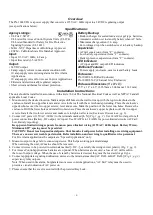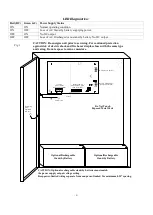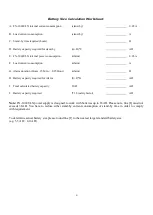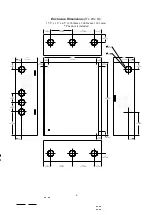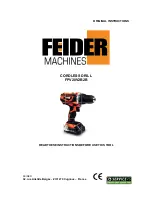
- 2 -
Overview:
The FN-1024ULX is a power supply that converts a 115VAC / 60Hz input to a 24VDC regulating output
(see specifications below).
Agency Listings:
•
UL File # S4707:
Specifications:
Battery Backup:
•
Built-in charger for sealed lead acid or gel type batteries.
UL Listed for Access Control System Units (UL 294).
UL Listed Standard for Safety for Fire Protective
Signaling Systems (UL 1481).
•
MEA - NYC Department of Buildings Approved.
•
CSFM - California State Fire Marshal Approved.
Input:
•
Input 115VAC / 60Hz, 4.2 amp.
•
Input fuse rated @ 5A/250V.
Output:
•
24VDC output.
•
8 amp supply current in non-alarm condition with
10 amp supply current during alarm for Fire Alarm
Applications.
10 amp supply current for Access Control Applications.
•
Filtered and electronically regulated outputs.
•
Short circuit and thermal overload protection.
•
Automatic switch over to stand-by battery when AC fails.
•
Maximum charge current 3.6 amp.
•
Zero voltage drop when switched over to battery backup.
Supervision:
•
AC fail supervision (form “C” contacts).
•
Low battery supervision (form “C” contacts).
•
Battery presence supervision (form “C” contacts).
LED Indicators:
•
AC input and DC output LED indicators.
Additional Features:
•
Power supply, enclosure, cam lock and battery leads
Enclosures:
FN-1024ULX-R (Red Enclosure)
FN-1024ULX-C (Charcoal Grey Enclosure)
Enclosure Dimensions
(H x W x D)
:
15.5” x 12” x 4.5” (393.7mm x 304.8mm x 114.3mm)
Installation Instructions:
The unit should be installed in accordance with article 760 of The National Electrical Code as well as NFPA 72 and all
applicable Local Codes.
1.
Mount unit in the desired location
.
Mark and predrill holes in the wall to line up with the top two keyholes in the
enclosure. Install two upper fasteners and screws in the wall with the screw heads protruding. Place the enclosure’s
upper keyholes over the two upper screws; level and secure. Mark the position of the lower two holes. Remove the
enclosure. Drill the lower holes and install two fasteners. Place the enclosure’s upper keyholes over the two upper
screws. Install the two lower screws and make sure to tighten all screws
(Enclosure Dimensions, pg. 6)
.
2.
Connect AC power (115VAC / 60 Hz) to the terminals marked [L, N]
(Fig. 1, pg. 3)
. Use 14 AWG or larger for all
power connections (Battery, DC output, AC input). Use 22 AWG to 18 AWG for power-limited circuits (AC Fail/
Low Battery reporting).
Keep power-limited wiring separate from non power-limited wiring (115VAC / 60Hz Input, Battery Wires).
Minimum 0.25” spacing must be provided.
CAUTION: Do not touch exposed metal parts. Shut branch circuit power before installing or servicing equipment.
There are no user serviceable parts inside. Refer installation and servicing to qualified service personnel.
For Fire Alarm applications the outputs are “Special Applications” only.
3.
Measure output voltage before connecting device. This helps avoiding potential damage.
When servicing the unit, AC mains should be removed.
4.
Connect devices to be powered to terminals marked [+ DC -], carefully observing correct polarity
(Fig. 1, pg. 3)
.
5.
For Access Control applications batteries are optional. When batteries are not used, a loss of AC will result in
the loss of output voltage. When the use of stand-by batteries is desired, they must be lead acid or gel type.
6.
Connect appropriate signaling notification devices to the terminals marked [AC FAIL & BAT FAIL]
(Fig. 1, pg. 3)
supervisory relay outputs.
Note: When used in fire alarm, burglar alarm or access control applications, “AC Fail” relay must be used to
provide a visual indication of AC power on.
7.
Please ensure that the cover is secured with the provided Key Lock.


